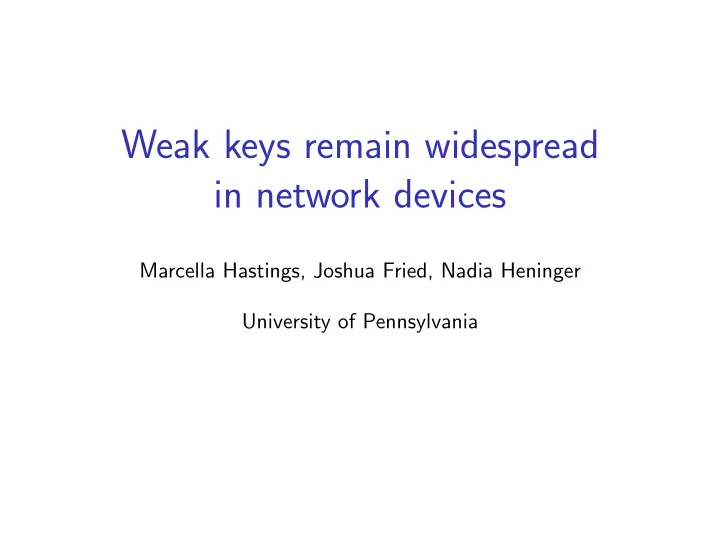

Weak keys remain widespread in network devices Marcella Hastings, Joshua Fried, Nadia Heninger University of Pennsylvania
Motivation [Mining Your Ps & Qs: Detection of Widespread Weak Keys in Network Devices: Heninger Durumeric Wustrow Halderman 2012; Public Keys: Lenstra et al. 2012] ◮ Factored 0.5% of HTTPS RSA public keys on the internet ◮ Weak keys were due to random number generator failures ◮ Affected only small network devices ◮ Major disclosure process to companies producing vulnerable products
What happened? A follow-up study. ◮ What happened since 2012? ◮ Did vendors fix their broken implementations? ◮ Can we observe patching behavior in end users?
Background on Ps and Qs: The GCD Vulnerability Public Key Private Key N = pq modulus p , q primes Vulnerability N 1 = pq 1 N 2 = pq 2 gcd( N 1 , N 2 ) = p = ⇒ Detect vulnerability by presence of factored key on host.
Methodology for this study What happens when we ask vendors to fix a vulnerability? 1. Aggregated internet-wide TLS scans from 2010-2016 2. Computed GCDs for 81.2 million RSA moduli 3. Identified vendors of vulnerable implementations 4. Examined results based on response to 2012 notification
Data sources: how to read the plots ◮ Scan sources along top of plot ◮ Scan dates on x-axis ◮ Absolute counts on y-axis Ecosystem Rapid7 Censys P&Q EFF 40M 30M Total 20M 10M 0M 80K Vulnerable 60K 40K 20K 0K 07/2010 12/2010 10/2011 06/2012 02/2014 07/2015 05/2016
Fingerprinting specific implementations Certificate subjects ◮ Cisco: OU=RV120W,O=Cisco Systems, Inc. ◮ Juniper: CN=system generated ◮ HP: O=Hewlett-Packard ◮ Xerox: O=Xerox Corporation ◮ Innominate: O=Innominate Shared primes heuristic Shared prime ⇒ same implementation.
Original notification ◮ Low response rates from vendors ◮ Took place March-June 2012 Vendor response to original notification Public Private Auto- No response Response Response responder 5 11 3 18
Research questions: what are we looking for? Prior work: what we hope to see ◮ Patch one implementation, notify many users [Debian OpenSSL: Yilek et al. 2009; Heartbleed: Durumeric et al. 2014] [Durumeric et al. 2014]
Research questions: what are we looking for? Prior work: what we hope to see ◮ Patch one implementation, notify many users [Debian OpenSSL: Yilek et al. 2009; Heartbleed: Durumeric et al. 2014] Questions ◮ What happened with different vendors? ◮ Did patch rates improve when vendors released a public advisory? ◮ Do we see the same trends as previous studies?
Innominate mGuard network security devices (Smart, PCI, Industrial RS, Blade, Delta, EAGLE) ◮ Public advisory in June 2012 ◮ Consistent population of vulnerable devices since 2012 ◮ New devices not vulnerable, but old devices not patched Ecosystem Rapid7 Censys P&Q EFF 600 400 Hosts Total 200 Vulnerable 0 07-2010 12-2010 10-2011 06-2012 02-2014 07-2015 05-2016
Juniper SRX Series Service Gateways (SRX100, SRX110, SRX210, SRX220, SRX240, SRX550, SRX650), LN1000 Mobile Secure Router ◮ Public security bulletin in April 2012, out-of-cycle security notice in July 2012 ◮ Majority of factored keys in 2012 were Juniper hosts ◮ Weird behavior in April 2014 Ecosystem Rapid7 Censys P&Q EFF 80K Total 60K Hosts 40K Vulnerable 20K 0K 07-2010 12-2010 10-2011 06-2012 02-2014 07-2015 05-2016
Juniper SRX Series Service Gateways (SRX100, SRX110, SRX210, SRX220, SRX240, SRX550, SRX650), LN1000 Mobile Secure Router ◮ 30,000 Juniper-fingerprinted hosts (9000 vulnerable) came offline after Heartbleed ◮ IPs do not reappear in later scans: TLS disabled, scans blocked, devices offline? Ecosystem Rapid7 Censys P&Q EFF 80K Total 60K Hosts Heartbleed 40K Vulnerable 20K 0K 07-2010 12-2010 10-2011 06-2012 02-2014 07-2015 05-2016
IBM Remote Supervisor Adapter II, BladeCenter Management Module ◮ Public security advisory (CVE-2012-2187) in September 2012 ◮ Prime generation bug: 36 possible public keys from 9 primes ◮ 100% of fingerprintable moduli are vulnerable P&Q Ecosystem Rapid7 Censys EFF Vulnerable Hosts 600 400 200 Heartbleed 0 07-2010 12-2010 10-2011 06-2012 02-2014 07-2015 05-2016
Cisco RV120W/220W, WRVS4400N, SA520/520W, RVS4000, SA540, RV180/180W, RV130, RV320, RV130W, ISA550/550W, ISA570 ◮ Substantial private response; no public advisory ◮ Vulnerable population rises for several years after notification Ecosystem Rapid7 Censys P&Q EFF 200K Total 100K 0K 10K Vulnerable 8K 6K 4K 2K 0K 07-2010 12-2010 10-2011 06-2012 02-2014 07-2015 05-2016
HP Integrated Lights-Out management card ◮ Substantial private response; no public advisory ◮ Internet reports: Integrated Lights-Out (iLO) management cards crash when scanned for Heartbleed Ecosystem Rapid7 Censys P&Q EFF 100 , 000 Total 50 , 000 Heartbleed 0 Vulnerable 30 20 10 0 07-2010 12-2010 10-2011 06-2012 02-2014 07-2015 05-2016
Linksys ◮ Did not respond to 2012 notification ◮ No evidence of patching: vulnerability decrease correlated with total decrease P&Q Ecosystem Rapid7 Censys EFF 150 , 000 Total 100 , 000 50 , 000 0 1 , 500 Vulnerable 1 , 000 500 0 07-2010 12-2010 10-2011 06-2012 02-2014 07-2015 05-2016
Huawei ◮ Introduced vulnerability in 2014 ◮ Security advisory published Aug 2016 Ecosystem Rapid7 Censys P&Q EFF 60 , 000 Total 40 , 000 20 , 000 0 Vulnerable 3 , 000 2 , 000 1 , 000 0 07-2010 12-2010 10-2011 06-2012 02-2014 07-2015 05-2016
End-User Patching Behavior ◮ Few vendors released patches; limited visibility into patching behavior. ◮ Patching rate is low: Decreasing vulnerability due to device churn. ◮ Low patch rate for devices has distressing implications for “Internet of Things” security [Yu et al. 2015] ◮ Vulnerability publicity campaigns (Heartbleed) effective, with unintended consequences
Failure in the Vendor Notification Process ◮ Security contact information is not available (16/42 vendors had discoverable contacts) ◮ Few public security advisories ◮ Organizations such as CERT/CC may increase vendor responses, but don’t result in signficant patching behavior [Arora et al. 2010, Li et al. 2016]
Standardizations: RFC 4086 “Care must be taken that enough entropy has been added to the pool to support particular output uses desired.” “Once one has gathered sufficient entropy, it can be used as the seed to produce the required amount of cryptographically strong pseudo-randomness”
Weak keys remain widespread in network devices Marcella Hastings, Joshua Fried, Nadia Heninger University of Pennsylvania
Recommend
More recommend